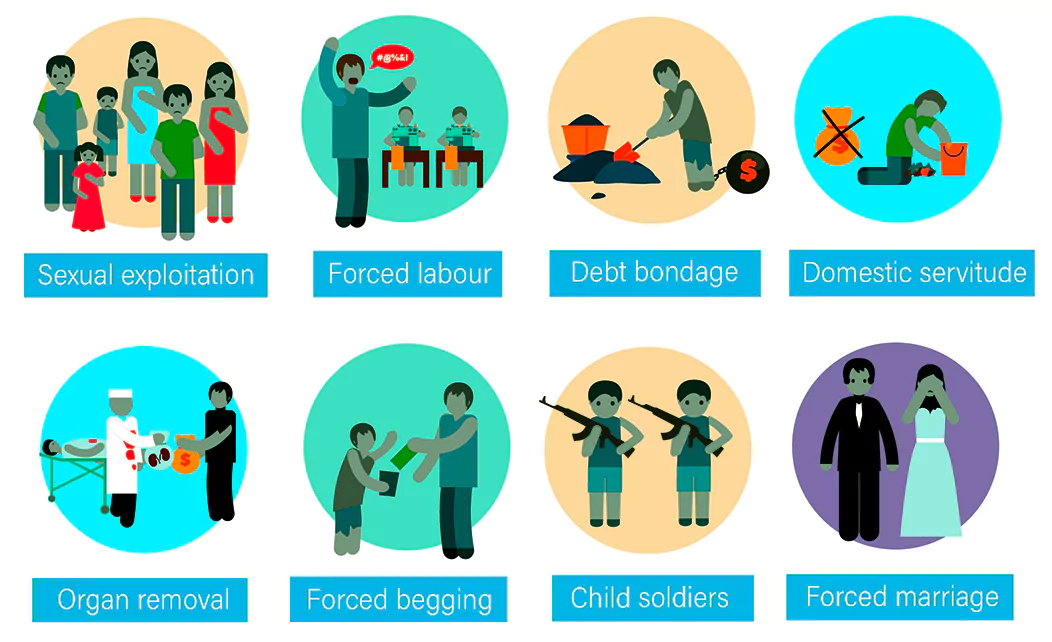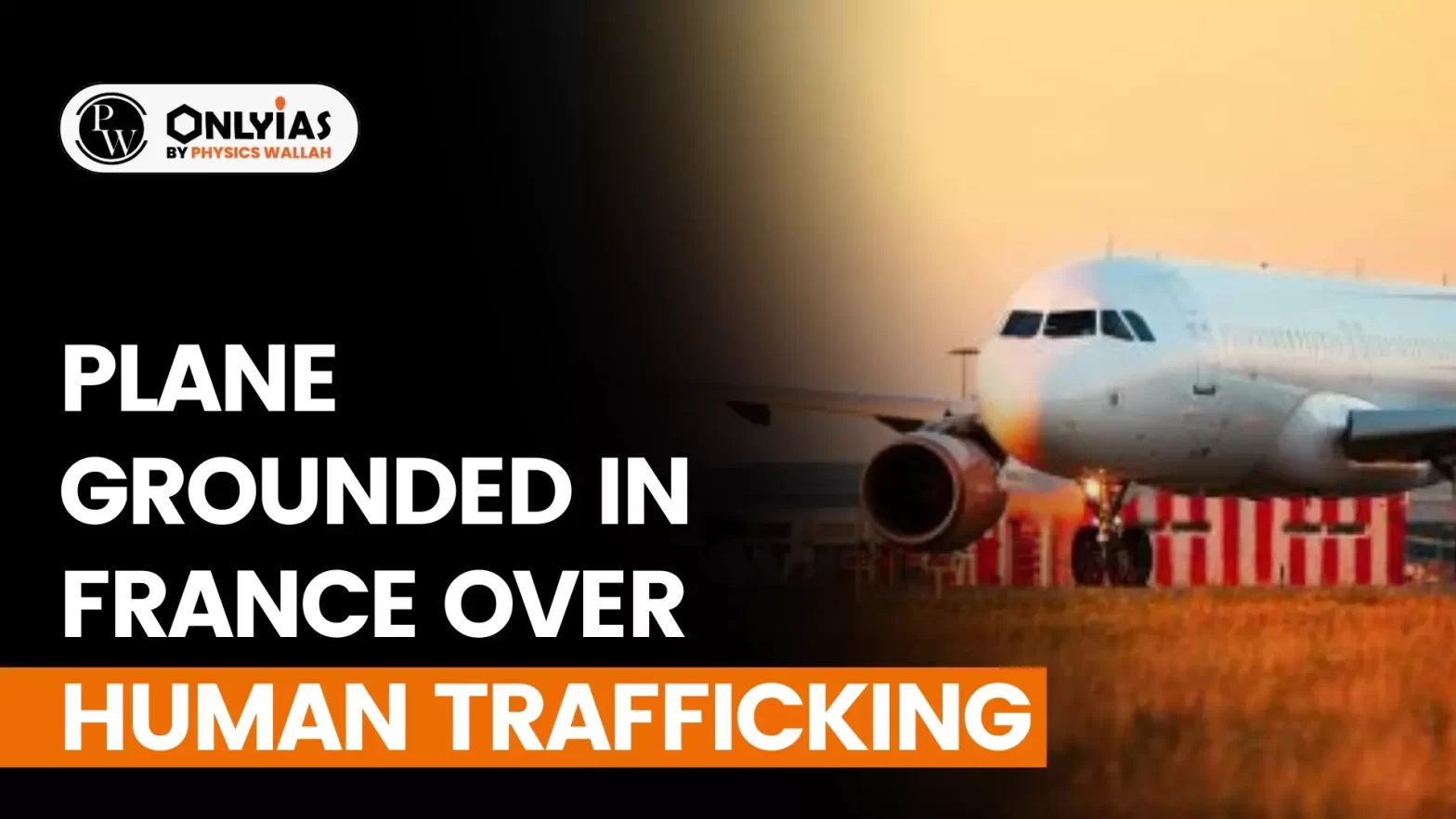Context: This article is based on the news “Human Trafficking or a plain case of migration?” which was published in the Live Mint. Recently, a Nicaragua-bound plane from Dubai carrying 303 Indian passengers was grounded in France over suspected human trafficking.
| Relevancy for Prelims: Article 23 (1), Immoral Traffic (Prevention) Act, 1956 (ITPA), Anti Trafficking Cell (ATC) and NCRB Data on Human Trafficking.
Relevancy for Mains: Human Trafficking: Causes, Impact, Status of Human Trafficking in India Constitutional and Legislative Provisions Related to Trafficking in India and the Government initiatives to Prevent and Combat Human Trafficking. |
Flight from Dubai: Grounded in France Amid Human Trafficking Suspicions
- Route of Flight: The flight that had taken off from Dubai in the United Arab Emirates with 303 passengers was grounded at Vatry airport, 150 kilometres east of Paris.
- French police intervened based on an anonymous tip about possible human trafficking.
- The plane, passengers, and crew were held for four days as authorities conducted a judicial inquiry.
- Return of Passengers: French authorities, allowed a charter jet carrying around 276 passengers, largely Indians, to fly to India.
- Application for Asylum: According to French authorities, 25 individuals, including two minors, expressed a desire to apply for asylum and remained on French soil.
- France’s anti-organised crime unit JUNALCO is now investigating, while the airline denies involvement in human trafficking.
- Suspected Reason for the Journey: Though the reason for their travel remains unknown, the Gujarat Police has formed teams to unearth a suspected illegal immigration network involving “agents”.
- Origin of the Passengers: Most passengers on the chartered plane that returned from France were from Banaskantha, Patan, Mehsana and Anand districts in Gujarat.
About Human Trafficking
- Human Trafficking is the recruitment, transportation, transfer, harbouring or receipt of people through force, fraud or deception, intending to exploit them for profit.
- Men, women and children of all ages and from all backgrounds can become victims of this crime, which occurs in every region of the world.
- The traffickers often use violence or fraudulent employment agencies and fake promises of education and job opportunities to trick and coerce their victims.
- Various Forms of Human Trafficking (refer image)

Causes of Human Trafficking
- Push Factors:
- Poor Socio-Economic Conditions: Widespread poverty and challenging socio-economic conditions in many families create vulnerability, pushing individuals towards traffickers in search of better opportunities.
- Natural Disasters and Destitution: Frequent natural disasters, such as floods, contribute to destitution, forcing people to seek alternative means of survival, often falling victim to traffickers.
- Lack of Education and Opportunities: Limited access to education and opportunities, especially for women in rural areas, enhances vulnerability as traffickers exploit the absence of skills and income options.
- Dowry Pressure: Pressure to collect money for dowries can lead families to send daughters to distant places for work, making them susceptible to trafficking.
- Dysfunctional Family Life: Family environments characterized by dysfunction, domestic violence, and low status of girl children contribute to the push factors, making individuals more susceptible to trafficking.
- Pull Factors:
- Demand for Marriage, Labor, and Adoption: Various demands, such as young girls for marriage, low-paid and underage labour, and adoption, create a pull for traffickers seeking to fulfil these demands through illicit means.
- High Burden on Women: Women made up the largest proportion of traffickers in 30 per cent of the countries which provided information on the gender of traffickers.
- Rise in Demand for Sex Industry: The growing demand for women in the sex industry serves as a pull factor, enticing traffickers to exploit vulnerable individuals for sexual exploitation.
- According to the 2009 report of the United Nations Office on Drugs and Crime, the most common reason for human trafficking (79 per cent) is sexual exploitation.
- The victims of sexual exploitation are predominantly women and girls.
Impact of Human Trafficking
- Physical Consequences: Victims often endure physical abuse, injuries, and exposure to diseases, including Sexually Transmitted Infections (STIs) and HIV.
- Psychological Consequences: The psychological toll is significant, with victims experiencing aggression, depression, disorientation, alienation, and difficulties in concentration.
- Mental health consequences include anxiety, depression, and post-traumatic stress disorder (PTSD). The mental well-being of survivors is often profoundly affected by the exploitation they endured.
- Difficulty in Reintegration: Victims often struggle to reintegrate into society and resume normal lives. The challenges may include social stigma, marginalization, and difficulties in rebuilding relationships.
- Violations of Human Rights: Human trafficking fundamentally violates the rights of victims, and conditional protection based on cooperation can further compromise their access to full human rights.
- Legal and Immigration Challenges: Victims may face legal and immigration challenges, complicating their recovery. Criminal proceedings may use trafficked persons as instruments, violating their rights and dignity.
Status of Human Trafficking in India
- In 2021, 2,189 cases of human trafficking were registered, reflecting a 27.7% increase from 2020.
- The National Crime Records Bureau (NCRB) reported 6,533 victims, comprising 2,877 children and 3,656 adults.
Continue Reading: NCRB Report 2022 On Crime In India
- The report accounts only for cases registered by the Anti-Human Trafficking Units (AHTUs).
- Regional Disparities:
- States with the highest reported cases in 2021 were Telangana, Maharashtra, and Assam, with 347, 320, and 203 cases, respectively.
- US Assessment of India’s Human Trafficking Laws (2023):
- The US’ 2023 Trafficking in Persons Report states that India “does not fully meet the minimum standards for the elimination of trafficking.”
- Indian Trafficking Overseas:
- Traffickers exploit Indian migrants seeking employment abroad, subjecting them to recruitment fraud or charging exorbitant fees.
- Forced labour victims from India have been identified in various countries, including Armenia, Portugal, Gabon, the United States, and Zambia.
Constitutional and Legislative Provisions Related to Trafficking in India
- Constitutional Provision:
- Article 23 (1): Prohibits trafficking in human beings or persons. It states, “Traffic in human beings and begar and other similar forms of forced labour are prohibited, and any contravention of this provision shall be an offence punishable by law.”
- Immoral Traffic (Prevention) Act, 1956 (ITPA):
- The ITPA is the primary legislation for preventing trafficking for commercial sexual exploitation.
- Criminal Law (Amendment) Act, 2013:
- Substituted Section 370 of the Indian Penal Code (IPC) with Section 370 and 370A, offering comprehensive measures to counter human trafficking.
- Addresses trafficking of children for various forms of exploitation, including physical and sexual exploitation, slavery, servitude, and forced organ removal.
- Protection of Children from Sexual Offences (POCSO) Act, 2012:
- Enacted to protect children from sexual abuse and exploitation.
- Defines different forms of sexual abuse, including penetrative and non-penetrative sexual assault and sexual harassment.
- Other Specific Legislations:
- Prohibition of Child Marriage Act, 2006
- Bonded Labour System (Abolition) Act, 1976
- Child Labour (Prohibition and Regulation) Act, 1986
- Transplantation of Human Organs Act, 1994
- Indian Penal Code (IPC):
- Specific sections such as Sections 372 and 373 deal with selling and buying of girls for prostitution.
- State-Specific Legislation:
- State governments have enacted specific legislation to address trafficking. For example, The Punjab Prevention of Human Smuggling Act, 2012.
Measures Taken by the Government of India to Prevent and Combat Human Trafficking
- Anti Trafficking Cell (ATC):
- Establishment of the Anti-Trafficking Nodal Cell in the Ministry of Home Affairs (MHA) as a focal point for communication and coordination.
- Anti-Human Trafficking Units (AHTUs): The MHA’s approved a proposal to establish 332 Anti Human Trafficking Units (AHTUs) in various districts nationwide. The Ministry provides financial assistance to the States for setting up the AHTUs.
- Judicial Colloquium:
- Organizing Judicial Colloquiums at the High court level to train and sensitize trial court judicial officers.
- Aims to address various issues concerning human trafficking and ensure a speedy court process.
- Eleven Judicial Colloquiums have been held in different states to date.
- Web Portal on Anti-Human Trafficking:
- MHA launched a Web Portal on Anti-Human Trafficking to provide information and resources.
- Enhancing accessibility to advisories and Standard Operating Procedures (SOPs).
- Ujjawala Scheme: The Ministry of Women and Child Development is implementing “Ujjawala” –a Comprehensive Scheme for Prevention of Trafficking and Rescue, Rehabilitation, Re-integration and Repatriation of Victims of Trafficking for Commercial Sexual Exploitation.
- New Legislation:
- The Trafficking of Persons (Prevention, Protection and Rehabilitation) Bill, 2018 was passed by Lok Sabha but could not be taken up in Rajya Sabha and subsequently lapsed.
- Draft of The Trafficking in Persons (Prevention, Care and Rehabilitation) Bill 2021 was published by the Ministry of Women and Child Development in June 2021.
Implementing International Conventions on Human Trafficking in India
- UN Convention:
- India has ratified the United Nations Convention on Transnational Organised Crime (UNCTOC).
- Protocol Implementation: Enacted the Criminal Law Amendment Act, 2013, defining human trafficking in line with the UNCTOC Protocol.
- SAARC Convention:
- India has ratified the SAARC Convention on Preventing and Combating Trafficking in Women and Children for Prostitution.
- Regional Task Force: Established a Regional Task Force for implementing the SAARC Convention.
- Study Tour: Conducted a study tour for SAARC Member countries to learn from the experiences of Anti Human Trafficking Units (AHTUs) in India.
- Bilateral Mechanism (India-Bangladesh):
- Task Force: Constituted a Task Force between India and Bangladesh to address cross-border trafficking issues.
- MoU: Signed a Memorandum of Understanding (MoU) in June 2015 for bilateral cooperation on preventing human trafficking, rescue, recovery, repatriation, and reintegration.
Way Forward to Prevent and Combat Human Trafficking
- Systematic Action: This type of human trade requires stringent correction measures within the system. The coordination of all agencies and authorities should be the first step.
- Enhance Role of Anti-Trafficking Units (AHTUs): A dedicated unit with trained personnel can reduce the burden on the police force and ensure efficient investigations.
- AHTUs can collaborate with stakeholders like courts, NGOs, and survivors, offering a holistic approach to combat trafficking.
- Lack of Reliable data: The lack of authentic global data makes it hard for governments and international organisations to battle trafficking successfully.
- There has to be an immediate strengthening of the information collection system and encouragement of countries to acknowledge and report crimes diligently.
- International cooperation: There must be strong international cooperation between law enforcement agencies of different countries and citizens.
- Stringent Punishments: There have to be stringent laws and legal actions against such crimes. The relatively low risk of trials has led to the increase of organised criminal groups utilising the gaps in the legal framework and feeble law enforcement and criminal justice systems.
- Technological Solutions: Develop advanced data analytics tools and artificial intelligence algorithms to analyze big data sets, identify trafficking trends, and predict potential hotspots.
- Utilize blockchain technology to enhance transparency in supply chains, preventing forced labor in industries prone to trafficking.
- Prevention through Education and Awareness: Implement comprehensive education programs to inform communities, especially vulnerable groups, about the risks and tactics of traffickers.
- Conduct awareness campaigns, workshops, and media initiatives to promote vigilance and empower individuals to recognize and report trafficking.
- Support and Rehabilitation for Victims: Establish comprehensive victim-centred support systems, offering shelter, healthcare, counselling, and vocational training for survivors.
- Ensure reintegration programs that help survivors rebuild their lives and reintegrate into society without stigma.
- Tackle Root Causes: Address poverty and economic disparities by creating sustainable livelihood opportunities and economic empowerment programs for vulnerable populations.
- Combat social discrimination and marginalization by promoting inclusivity, equality, and social support structures.
Conclusion:
The grounded plane in France highlights the urgent global need for strong laws, international collaboration, and support for survivors to combat human trafficking effectively.
![]() 27 Dec 2023
27 Dec 2023


